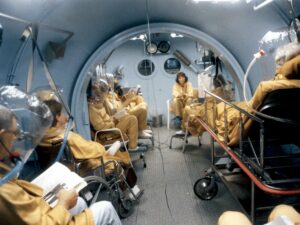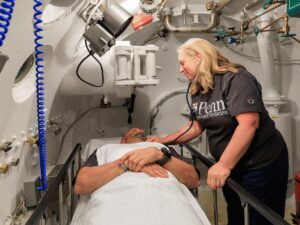Ever wondered why accreditation standards matter for hyperbaric facilities? Accreditation standards not only ensure compliance with industry best practices but also elevate the quality of care provided.
As an expert in the hyperbaric chamber field, our insights are based on extensive industry experience and knowledge. Trust us to guide you through the complexities of accreditation.
Navigating the accreditation standards for hyperbaric facilities can seem daunting. However, understanding these guidelines is essential for ensuring safety, efficacy, and compliance.
In this guide, we will explore the key accreditation standards, the process of achieving and maintaining accreditation, and why it matters for business.
Dive deeper to empower the facility with the excellence of accreditation!
1. Overview of Accreditation Bodies for Hyperbaric Facilities
Navigating the landscape of accreditation bodies for hyperbaric facilities can feel like a maze. Each body sets its unique standards focusing on patient safety, quality of care, and operational excellence. These organizations play a pivotal role in shaping the future of hyperbaric medicine, ensuring facilities meet stringent requirements to offer top-notch services.
Accreditation is not just a special award, it’s a promise to keep getting better. This is really important in the world where hyperbaric oxygen therapy is expected to expand at a compound annual growth rate (CAGR) of 4.9% from 2023 to 2030, according to Grand View Research. It shows how big and important it is to stay top-notch in this area.

2. Benefits of Accreditation for Facilities and Patients
After exploring the overview of accreditation bodies for hyperbaric facilities, it’s clear to my mind that the role of these entities is vital. Here are the benefits of accreditation for facilities and patients:
Elevates Facility Standards
Accreditation pushes facilities to adhere to high standards of care and operation. This process ensures that hyperbaric chambers are safe, efficient, and up-to-date with the latest healthcare protocols, just like what Oxygen-Ark is implementing. It’s a mark of excellence that facilities proudly display, distinguishing them from competitors and instilling confidence in their services.
Enhances Patient Safety and Care
For patients, the accreditation of a facility is synonymous with safety and quality care. It assures them that the facility meets rigorous health and safety standards, reducing the risk of complications. I believe this peace of mind is priceless for patients and their families. Just like Oxygen-Ark, we offer the best quality chambers for all. Assuring we are in capable and accredited hands.
Improves Business Operations
From a business perspective, accreditation streamlines operations, ensuring they are lean and effective. It necessitates regular reviews and updates of practices, which can lead to operational efficiencies, cost savings, and improved patient outcomes. Facilities that achieve and maintain accreditation are often seen as leaders in the field, attracting more patients and partnerships.

3. Key Accreditation Standards for Hyperbaric Facilities
Reflecting on the benefits of accreditation for facilities and patients highlights how accreditation fosters higher standards and better outcomes. Here are the key accreditation standards for hyperbaric facilities:
Certification in Hyperbaric Technology
Employees, especially those handling hyperbaric therapies, are required to be certified hyperbaric technologists. This qualification comes from specific training courses that teach the basics of hyperbaric medicine. For example, a technician at a medical spa offering hyperbaric oxygen therapy would need this certification to ensure safe and effective treatment administration.
Advanced Cardiac Life Support (ACLS) Certification
For healthcare providers working within hyperbaric facilities, having an Advanced Cardiac Life Support (ACLS) certification is crucial. This ensures they are prepared to respond to cardiac emergencies, which could occur during hyperbaric oxygen therapy sessions.
Wound Care Education
Given the significant role of hyperbaric oxygen therapy in wound healing, staff members are often required to have formal education or training in wound care. This enables them to better assess and manage patients with chronic wounds, optimizing the therapeutic benefits of hyperbaric treatments.
4. The Process of Achieving Accreditation
After understanding the key accreditation standards for hyperbaric facilities, I guess facilities might feel eager yet apprehensive about the accreditation process. Here are the critical steps involved in achieving accreditation:
Step#1 Self-Assessment and Gap Analysis
The first step involves conducting a thorough self-assessment against the accreditation standards. Facilities must identify areas of non-compliance and opportunities for improvement. This gap analysis is crucial for developing an action plan to address deficiencies and align operations with the required standards.
Step#2 Documentation and Policy Development
Based on the gap analysis, facilities need to update or develop policies and procedures that comply with accreditation standards. For example, creating or revising treatment protocols, safety procedures, and emergency plans. Documentation plays a pivotal role in demonstrating compliance during the accreditation review process.
Step#3 Staff Training and Education
Ensuring that all staff members meet the specific qualifications and training requirements is a key component of the accreditation process. Facilities must organize training sessions on the latest hyperbaric practices, safety protocols, and emergency response. Ongoing education ensures that the team remains competent and up-to-date with industry standards.
Step#4 On-site Survey and Evaluation
The culmination of the accreditation process is the on-site survey conducted by the accrediting body. This involves a comprehensive review of the facility’s operations, policies, patient care practices, and compliance with safety standards. Facilities must demonstrate adherence to all accreditation requirements through direct observation, interviews, and document reviews.

5. Challenges and Solutions in Achieving Accreditation
Navigating through the process of achieving accreditation can unveil a series of hurdles that facilities may not initially anticipate. Here are the common challenges and practical solutions in securing accreditation:
Financial Constraints
The cost of meeting all accreditation standards, including upgrading equipment and facilities, can be substantial. To address this, facilities can seek financial grants, loans, or look for incremental investments in upgrades, focusing first on those that significantly impact patient care and safety.
Staff Training and Retention
Ensuring all staff are adequately trained and meet the qualifications can be challenging, especially in regions with a shortage of trained professionals. To resolve this, facilities can invest in in-house training programs and offer incentives for continuous education, enhancing staff skills and improving retention rates.
Documentation and Compliance
Keeping up with the extensive documentation required for accreditation can be overwhelming. To tackle this, implementing an electronic health record (EHR) system and providing regular training on documentation practices can help streamline the process. Automating as much of the process as possible can also reduce errors and improve compliance.
Maintaining Continuous Quality Improvement
Establishing a culture of continuous quality improvement requires ongoing effort and commitment. To facilitate this, regular internal audits, feedback mechanisms, and engaging staff in quality improvement initiatives are crucial. Celebrating small wins and continuous progress can make the journey towards improvement more rewarding and effective, right?
| Strategy |
Description |
| Regular Internal Audits |
Conduct routine assessments of processes, systems, and outcomes to identify areas for improvement and ensure compliance with quality standards. |
| Feedback Mechanisms |
Implement systems for collecting feedback from customers, employees, and stakeholders to gather insights for enhancing products or services. |
| Engaging Staff in Improvement Initiatives |
Involve employees at all levels in identifying problems, brainstorming solutions, and implementing changes to foster a culture of ownership and innovation. |
| Celebrating Small Wins |
Recognize and celebrate incremental achievements and milestones to boost morale, motivation, and engagement in the quality improvement process. |
| Monitoring Continuous Progress |
Track key performance indicators (KPIs) and metrics to monitor progress, identify trends, and make data-driven decisions to sustain quality improvements over time. |
6. 3 Practical Tips for Successful Accreditation
After discussing the challenges and solutions to achieving accreditation, there is no doubt that a strategic approach is key to success. Here are practical tips for successful accreditation:
#1 Electronic Health Records (EHRs)
The adoption of electronic health records is a game-changer for facilities aiming for accreditation. EHRs streamline patient data management, ensuring that medical records are accurate, up-to-date, and accessible. This technology supports compliance with documentation standards required for accreditation by providing a centralized platform for all patient-related information.
#2 Mock Surveys
Conducting mock surveys is a critical step in preparing for the accreditation site visit. These simulations replicate the accreditation body’s survey, allowing facilities to identify areas of non-compliance and address them before the actual review. During a mock survey, staff members practice articulating their roles, responsibilities, and how they contribute to meeting accreditation standards.
#3 Continuous Quality Improvement (CQI) Program
Don’t wait for accreditation to focus on quality improvement. Establish ongoing quality improvement initiatives that align with accreditation standards. This not only prepares for accreditation but also improves patient care and operational efficiency.
Dive Deeper Into Our Resources
For some insightful reads, we’ve curated a list of recommended articles just for you:
Still haven’t found what you’re looking for? Don’t hesitate to contact us. We’re available around the clock to assist you.
Conclusion
The journey towards accreditation is a rewarding path that leads to recognized excellence in hyperbaric medicine. It’s about building a culture of quality that benefits everyone involved, from the dedicated staff to the patients who trust in their care.
For hyperbaric facilities seeking to elevate their services and achieve accreditation, partnering with a reputable and experienced manufacturer like Oxygen-Ark can make a significant difference. Contact us today!



